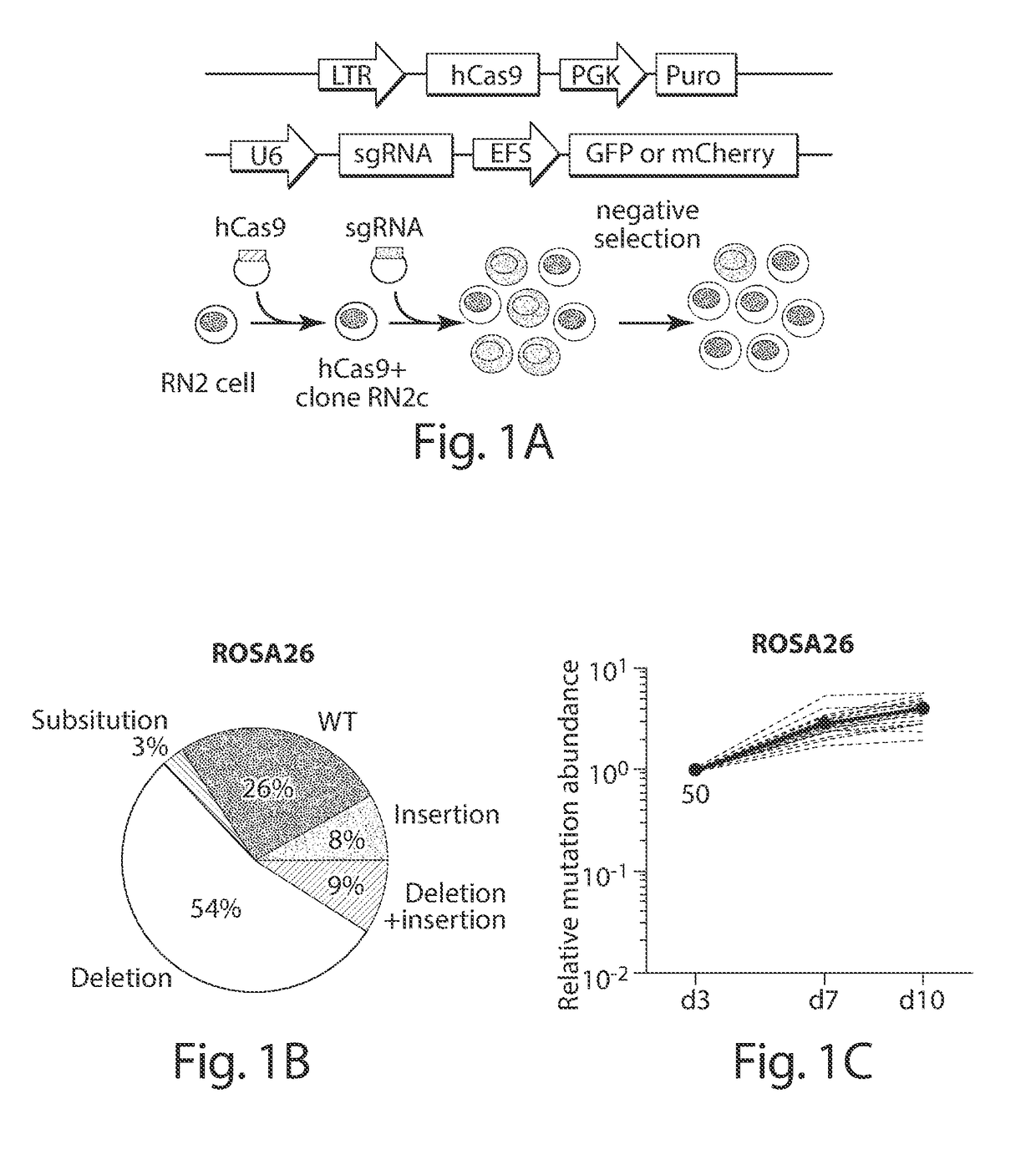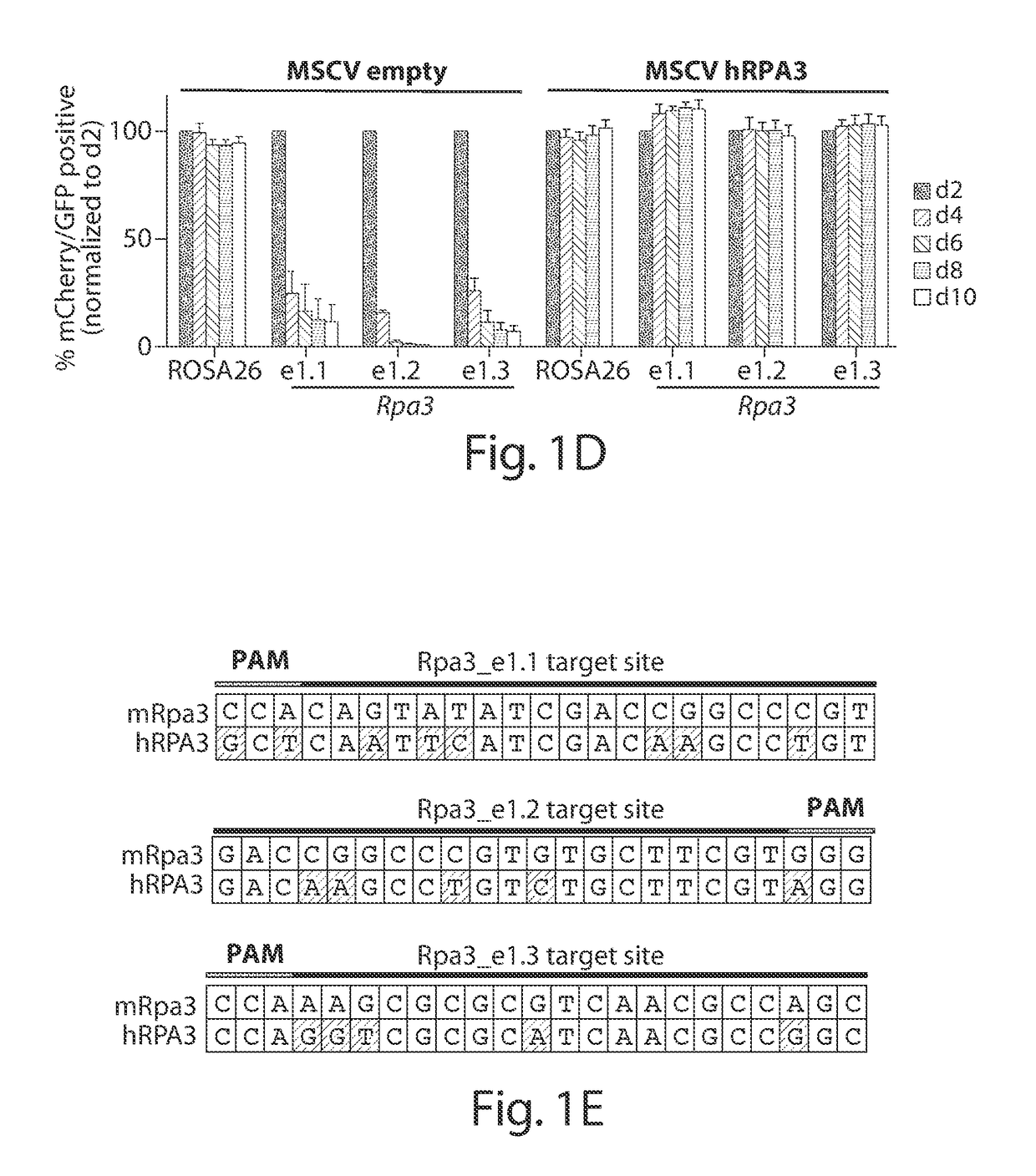Methods of identifying essential protein domains
- Summary
- Abstract
- Description
- Claims
- Application Information
AI Technical Summary
Benefits of technology
Problems solved by technology
Method used
Image
Examples
example 1
[0064]CRISPR-based mutagenesis methods provided herein are based, in part, on negative selection experiments using a murine MLL-AF9 / NrasG12D acute myeloid leukemia line (RN2), which has been used extensively to identify dependencies (e.g., genes essential for cell viability) using RNA interference. A clonal Cas9+ line (RN2c), which is diploid and remains genomically stable during passaging, was derived (FIG. 1A). Lentiviral transduction of RN2c cells with a vector expressing a GFP-linked sgRNA targeting the ROSA26 locus resulted in a high efficiency of indel mutations near the predicted cut site, which reached >95% editing efficiency by day 10 post-infection (FIG. 1B, C).
[0065]Next, how mutagenesis of an essential gene influences the maintenance of sgRNA positivity during cell culturing was examined using three sgRNAs designed to target the first exon of Rpa3, which encodes a 17 kD protein required for DNA replication. Unlike the effects of targeting ROSA26, cells expressing Rpa3 sg...
example 2
[0068]In the experiments described in Example 1, there was significant variability in the performance of individual sgRNAs targeting the same gene. For example, two of the Brd4 sgRNAs became depleted >50 fold while two were only depleted ˜2-fold over eight days in culture (FIG. 1I). Using SURVEYOR assays, data showed that the variation in phenotype severity was not due to differences in overall mutagenesis efficiency, but rather was due to stronger negative selection pressure against cells harboring the different sgRNA-induced mutations (FIGS. 4A and 4B). Interestingly, the Brd4 sgRNAs causing severe phenotypes targeted sequences encoding bromodomain 1 (BD1), while the sgRNAs causing weaker phenotypes targeted more N-terminal regions outside of the bromodomain (FIG. 2A). Prior studies showed that the bromodomains of Brd4 are necessary for leukemia maintenance, as evidenced by the anti-leukemia activity of small-molecule Brd4 bromodomain inhibitors. Without being bound by theory, it ...
example 3
[0073]One implication of the experiments described in Examples 1 and 2 is that negative selection CRISPR screens that seek to discover therapeutic targets should utilize sgRNA libraries that target protein domains predicted to be amenable to chemical inhibition. To evaluate this, a sgRNA library was designed to target all of the known lysine methyltransferase (KMT) domains, a target class for which selective small-molecule KMT inhibitors have demonstrated anti-proliferative effects in MLL-AF9 leukemia, such as inhibitors of Dot1l, Ezh2, and Ehmt1 / 2 (FIG. 3A). These experiments were aimed at determining whether a KMT domain-focused CRISPR screen would identify these known dependencies and, potentially, reveal additional requirements. The impact of ˜150 sgRNAs targeting all 34 KMT domains was evaluated using sgRNA / GFP-depletion assays over 12 days (FIG. 3B). Importantly, Dot11, Ezh2, Ehmt1, and Ehmt2 KMT domain-targeting sgRNAs led to a consistent and pronounced negative selection and...
PUM
 Login to View More
Login to View More Abstract
Description
Claims
Application Information
 Login to View More
Login to View More - R&D
- Intellectual Property
- Life Sciences
- Materials
- Tech Scout
- Unparalleled Data Quality
- Higher Quality Content
- 60% Fewer Hallucinations
Browse by: Latest US Patents, China's latest patents, Technical Efficacy Thesaurus, Application Domain, Technology Topic, Popular Technical Reports.
© 2025 PatSnap. All rights reserved.Legal|Privacy policy|Modern Slavery Act Transparency Statement|Sitemap|About US| Contact US: help@patsnap.com



